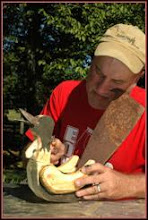I have had many of you request the recipe I use for making my paper clay. The recipe is not original to me. I found the mixture formulation on a website by artist Jonni Good. As has been true by so many in the artist community, she is very willing to share her knowledge.
Although you will not find this recipe to be an exact replica of Jonni's, it has been the mixture that has worked best for my purposes. I would encourage each of you to experiment with the materials and modify the recipe according to your needs. Jonni's site has other valuable resources and helpful links that I would encourage you to use if you are attempting the medium of paper mache' for the first time.
You will find that there is no single paper mache' technique that will work for each idea you have. You will likely need to familiarize yourself with a variety of methods, so as to be able to expand your range of work.
As a fellow artist friend shared with me today, "get your hands dirty and create" So, what are you waiting for, give it a try!!!
Paper Clay
1 - large double roll of toilet paper (makes about 3 cups)(I use the cheapest Walmart brand)
1 1/2 cups - Elmers GlueAll
2 cups - all purpose drywall compound (ready mixed) I generally use the one gallon size because I
don't want it drying out; you will likely need the 5 gal. buckets due to the larger batch sizes you
may eventually use
1 - cup all purpose flour
4 tablespoons of linseed oil (assists in preventing mold growth)
2 – small 1 - 2 gallon buckets or comparably sized containers
1 – 12” x 12” fiberglass window screen fabric (used as a filter and for squeezing out excess water)
1- dull butter knife (I use this both to mix my paper clay, as well as, to apply it)
1 – pair of non-latex gloves
How To Mix
1. Unroll one roll of toilet paper in a small 1-2 gallon bucket.
2. Cover the toilet paper with enough warm water to completely cover your pulp.
3. Use a butter knife to stir & breakdown your paper into a fine pulp.
4. Using a piece of fiberglass window screen fabric as a filter over another small bucket
(approximately 12" x 12"), pour about 1/3 of your paper pulp through the filter.
5. Squeeze-out most of the water from the pulp, by wrapping the screen cloth around the
pulp, and place the ball of pulp aside.
6. Repeat filtering the pulp through the screen cloth and squeezing it out with the remaining
2/3 of the wet pulp.
7. When all pulp has been filtered, place back into a bucket and break it up into the smallest
pieces as is possible.
8. Add the remaining ingredients on top of the pulp and begin mixing thoroughly; make sure
to mix all of the dry ingredients into the wet mixture(continue to break-up any clumps of
pulp)(I have found a dull butter knife the most effective tool to assist in mixing this
mixture)
9. If thoroughly mixed, the batch should look like a bucket full of lumpy oatmeal.
10. If not ready to use, cover and refrigerate.
Top Coat Slurry Mixture
I use this slurry mixture to help “smooth out” the surface of my pieces. Also, the slurry is helpful when adding-on detailed features or building-up or enhancing existing features. The slurry works great over areas where traditional strip paper mache' may need to be blended to hide strip overlap. The slurry is easily tinted with acrylic paints to achieve base colors when applying over a large area.
1 – part drywall compound
1- part Elmer's GlueAll
mix in a container with a tight fitting lid. Make sure to blend the two ingredients thoroughly to get any lumps out. An old mixer would work great to assist in making larger batches. This mixture also refrigerates well.

Do not tell your Grandchildren about this recipe UNLESS you plan to do said project with them!
ReplyDelete